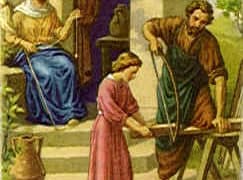And truly, I say to you, wherever the gospel is proclaimed in the whole world, what she has done will be told in memory of her.
–Jesus of Nazareth
One of the more intriguing stories that Mark preserves is that of an unnamed woman who anoints Jesus’ head with an alabaster flask of perfumed oil of pure nard, a fragrant Near Eastern plant, a few days before his death (Mark 14:1-9). The scene takes place at Bethany, a small village on the east slope of the Mt. of Olives. Jesus and his disciples stayed in this village the last week of his life, making it their “base of operations” for the decisive events of that led up to Passover (Mark 11:11-12). Based on John’s account it seems likely that they are staying in the home of the sisters Martha and Mary and their brother Lazarus, a Jerusalem family with whom Jesus was very close (John 11:1-5; Luke 10:38-42). The scene of the anointing took place in the house of one “Simon the leper,” who also lived in Bethany, according to Mark, but John explains that the sisters Mary and Martha served, and that their brother Lazarus was one of those at table with them (Mark 14:3; John 12:1-8). Mark never mentions the sisters Martha and Mary and their brother Lazarus anywhere in his gospel. Even though some of the details of the accounts in Mark and John differ, it is certain that they are narrating the same event and my sense is that John has an independent tradition from that of Mark. As far as the anointing story goes, Matthew essentially follows Mark and seems to have nothing independently.

I think it is important to read Mark and John side by side, as two independent traditions. Even if John knows Mark, which I take as likely, his version of the story is more than a “retelling” of the story using Mark as a source. He seems to draw upon sources unavailable to Mark. John clearly names the woman as Mary, stating she is the sister of Martha and Lazarus (John 11:2; 12:3). Mark and John both note that the pure oil of nard was very costly, worth 300 denarii, which would be months of wages for a common laborer. John does not mention the oil poured on Jesus’ head but on his feet, and he adds the detail of Mary then wiping his feet with her hair, which surely seems to be an intimate act of devotion. When some at the table object (Judas Iscariot according to John) that such a costly flask of oil should be sold and given to the poor, Jesus rebukes them with his famous statement “The poor you always have with you” which both Mark and John know. The theological irony in this double tradition, even with its differences, is that Jesus the “Christ,” or Anointed One, is anointed by a woman, and that this anointing is in connection with his burial. In other words, for both Mark and John, Jesus is the “dead messiah,” triumphant only through resurrection of the dead. But if we read behind the theology we seem to have access to a tradition that remembers a specific event–namely that Jesus was anointed by a woman named Mary at Bethany.
Mark and John differ in a crucial way when Jesus characterizes this act of anointing. In Mark he says the woman has “anointed his body beforehand for burial,” but in John he says, rather than sell the ointment it should be kept to be used for “the day of his burial” (John 12:7). Yet John has no account of Mary or any of the women preparing to anoint Jesus’ body for burial. Instead he says that Joseph of Arimathea, assisted by Nicodemus, carried out these rites based on Jewish customs (John 19:40). But Mark notes explicitly that Mary Magdalene, Mary the mother of James and Joses (whom I take to be Jesus’ mother, see above), and Salome, bought spices so that they might go and anoint him once the Sabbath was past (Mark 16:1).
Sorting out the roles of these two Marys, Mary Magdalene and Mary the sister of Martha, in the final days of Jesus’ life is difficult. Mark never mentions the sisters Mary and Martha and he gives no name for the woman who anoints Jesus. John mentions the sisters, has Mary anointing Jesus at Bethany, but does not have them either at the cross or the intended anointing at the tomb, which seems odd given their close and intimate relationship to Jesus. Both Mark and John first mention Mary Magdalene at the crucifixion, and they agree that Mary Magdalene visits the tomb of Jesus early Sunday morning, but Mark writes that she came with the Jesus’ mother and Salome, while John has her come alone. If the unnamed woman who anointed Jesus in Mark was in fact Mary Magdalene, her faithfulness at the cross and intimacy at the burial seems appropriate. On the other hand, if this woman was Mary, sister of Martha, as John says explicitly, why is she not involved in the final crucifixion and tomb scenes? After all, John’s account, with the wiping of the feet with her hair, seems even more intimate than Mark’s anointing of the head. One can either accept each account at face value and deal with the tensions and differences, or look for solutions that account for both, but might be nearer the historical situation as we can construct it.
Luke drops Mark’s anointing at Bethany story entirely, but he narrates a strikingly similar story, set in Galilee, much earlier in Jesus’ career, where an unnamed woman, who is a “sinner” anoints Jesus’ feet with an ointment, wets them with her tears, kisses, them, and dries them with her hair (Luke 7:36-50). This story seems juxtaposed purposely with his introduction of Mary Magdalene into his narrative, where he alone, of all the gospels, says she had been exorcised of seven demons (Luke 8:2). One is tempted to conclude that Luke understands the woman in the Bethany anointing to be none other than Mary Magdalene, and that he is uncomfortable with the intimate and positive role she is given in that scene. Luke also removes the explicit names of the women at the cross and burial of Jesus, including Mary Magdalene, referring generically to “the women who had followed him from Galilee” (Luke 23:49, 55). Luke’s editing of Mark in this regard paves the way for the negative image of Mary Magdalene as a sexually loose and deranged woman that became so pervasive in later Christian tradition, particularly as promulgated by Clement of Alexandria, Origen, Tertullian, Ambrose, Jerome, Augustine, and of course Pope Gregory the Great (late 6th century). It became common to identify Mary Magdalene with the sister of Martha as well as the “sinful” woman in Luke’s anointing story.
I am convinced that this denigration of Mary Magdalene, evidenced so explicitly by Luke, is also behind John’s assertion that it was Mary of Bethany, sister of Lazarus and Martha, who anointed Jesus before his death. They both know the name of the woman who was commended for this act was named “Mary” and I think that both of them are aware of a tradition that she was none other than Mary Magdalene. Mark says the scene took place in Bethany in the house of “Simon the leper” but John does not mention that, implying it might well have been in the home of Lazarus and the sisters. Luke is content to let that stand, but leaves the implication that she is a deranged sinner. John knows a tradition that heightens the intimacy of the scene, as well as connects this “Mary” to a subsequent anointing of Jesus’ body for burial. To have Mary Magdalene involved in both of these acts is problematic for him, or at least for the final editors of this gospel. He is so eager to identify the anointing “Mary” as the sister of Martha that he even mentions the scene in the past tense before it happens! (John 11:2). I think this is a real clue as to what is going on at some stage of the editing of John. John’s tradition includes the striking scene between Jesus and Mary Magdalene at the tomb (20:11-18), but if she is also the woman who touches Jesus’ feet with her hair and is involved in anointing his body for burial, her position of prominence and intimacy would just be too great. Both are acts that involve “nakedness,” that of a woman’s hair and the intimacy involved in the preparation of a corpse for burial.
John and Luke were written at a time when the male apostles, namely Peter and Paul are being invested with great authority. Although Mary Magdalene was remembered and honored in certain circles, as witnessed by other texts outside the New Testament, her place in our canonical gospels is explicitly muted. I think a critical reading of Mark and John gives us some glimmer of what might have been going on and by reading the texts side by side we can perhaps rehabilitate Mary’s Memorial. How sad, tragic, and completely inexcusable that such a dear woman who meant so much to Jesus has been turned into a loony-tunes crazy woman, or worse, a whore.
For more on what we can recover of the historical Mary Magdalene, see the four part series beginning here: “There’s Something About Mary…Magdalene.”









Comments are closed.